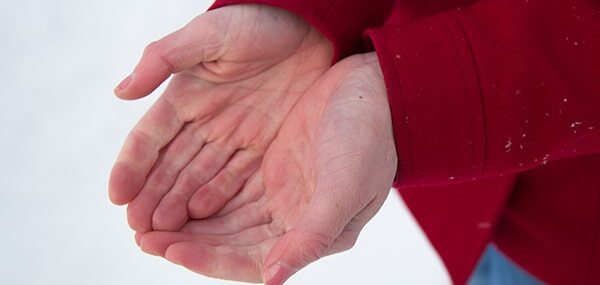
Frostbite is an injury caused by freezing of the skin and underlying tissues. First your skin becomes very cold and red, then numb, hard and pale. Frostbite is most common on the fingers, toes, nose, ears, cheeks and chin. Exposed skin in cold, windy weather is most vulnerable to frostbite. But frostbite can occur on skin covered by gloves or other clothing. Because of skin numbness, you may not realize you have frostbite until someone else points it out.
Frostbite requires medical attention because it can damage skin, tissues, muscle and bones. Possible complications of severe frostbite include infection and nerve damage. Specific conditions that lead to frostbite include:
- Wearing clothing that isn’t suitable for the conditions you’re in — for example, it doesn’t protect against cold, windy or wet weather or it’s too tight.
- Staying out in the cold and wind too long. Risk increases as air temperature falls below 5 F (minus 15 C), even with low wind speeds. In wind chill of minus 16.6 F (minus 27 C), frostbite can occur on exposed skin in less than 30 minutes.
- Touching materials such as ice, cold packs or frozen metal.
Signs and symptoms of frostbite include:
- At first, cold skin and a prickling feeling
- Numbness
- Red, white, bluish-white or grayish-yellow skin
- Hard or waxy-looking skin
- Clumsiness due to joint and muscle stiffness
- Blistering after rewarming, in severe cases
Frostbite Prevention
Here are tips to help you stay safe and warm.
- Limit time you’re outdoors in cold, wet or windy weather. Pay attention to weather forecasts and wind chill readings. In very cold, windy weather, exposed skin can develop frostbite in a matter of minutes.
- Dress in several layers of loose, warm clothing. Air trapped between the layers of clothing acts as insulation against the cold. Wear windproof and waterproof outer garments to protect against wind, snow and rain. Choose undergarments that wick moisture away from your skin. Change out of wet clothing — particularly gloves, hats and socks — as soon as possible.
- Wear a hat or headband that fully covers your ears. Heavy woolen or windproof materials make the best headwear for cold protection.
- Wear mittens rather than gloves. Mittens provide better protection. Or try a thin pair of glove liners made of a wicking material (such as polypropylene) under a pair of heavier gloves or mittens.
- Wear socks and sock liners that fit well, wick moisture and provide insulation. You might also try hand and foot warmers. Be sure the foot warmers don’t make your boots too tight, restricting blood flow.
- Watch for signs of frostbite. Early signs of frostbite include red or pale skin, prickling, and numbness. Seek warm shelter if you notice signs of frostbite.
- Plan to protect yourself. When traveling in cold weather, carry emergency supplies and warm clothing in case you become stranded. If you’ll be in remote territory, tell others your route and expected return date.
- Don’t drink alcohol. Alcoholic beverages cause your body to lose heat faster.
- Eat well-balanced meals and stay hydrated. Doing this even before you go out in the cold will help you stay warm.
- Keep moving. Exercise can get the blood flowing and help you stay warm, but don’t do it to the point of exhaustion.
- Seek medical attention for frostbite if you experience signs and symptoms of superficial or deep frostbite, increased pain, swelling, redness or discharge in the area that was frostbitten, fever or new unexplained symptoms.
Frostbite can be a dangerous condition, but taking a few precautions and being aware of the risks will go a long way to keeping you safe outdoors this winter.









